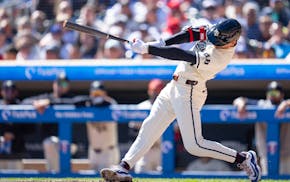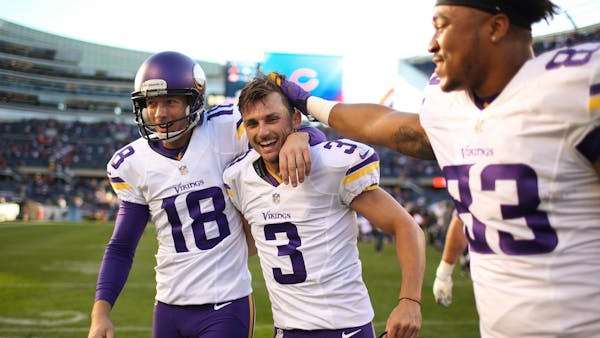1. Screen defense changed game
It was pretty clear what the Bears' intentions on offense were Sunday. With versatile running back Matt Forte, Chicago was going to spread the Vikings' big personnel out and throw screens until the Vikings proved they had the speed to stop it. "We knew what they were going to run," middle linebacker Eric Kendricks said. "They did spread us out. But we're fast. We're fast and we were expecting it." Kendricks had a tackle for no gain on a bubble screen to receiver Eddie Royal that forced the Bears to settle for a 55-yard field goal on their opening drive. Moments later, one of cornerback Terence Newman's team-high eight tackles was a similar stop to force a punt. "Everyone made their plays when they had to on those screens," Kendricks said. "It was a crucial part of changing the game early."
2. Hang on Andrew, hang on
The only reason the Vikings had a full minute to run their offense at the end of the game is because the Bears had the ball for only 49 seconds during a three-and-out session before that. Yes, Chicago made it easier when rookie running back Jeremy Langford, playing because Forte was hurt, dropped what would have been a first-down reception on third-and-5. But don't undersell the effort by strong safety Andrew Sendejo on first down. It was the 6-1, 210-pound Sendejo who reacted quickly and latched on to the ankles of 6-6, 273-pound tight end Martellus Bennett to hold him to a 5-yard gain. "He ran an in route and I just tried to close as quick as I could and make the tackle," Sendejo said. "He's a big guy. You just have to wrap up anything you can grab and hold on while your buddies help get him down. He's a hard dude to take down."
3. Matt's attack
Third-and-6 on the road is a noise-inducing pain. False-starting to make it third-and-11 is typically a punt waiting to happen. Unless backup running back Matt Asiata has the ball, a head of steam and new star receiver Stefon Diggs willing to do some blocking. All of that came together early in the second quarter after Vikings left tackle Matt Kalil was flagged for a false start. On the next snap, Teddy Bridgewater was pressured from the pocket when he flicked the ball to Asiata in the backfield. "I was the last option for Teddy on that one," Asiata said. "No one was open, so he gave me the ball. I saw Diggs throwing the block and I just went straight north on that one. North and south. That's how I run." Asiata gained 12 yards to extend a drive that ended with a field goal.
4. Pressure was there
A week ago, the Vikings had seven sacks against an outcoached Lions team. Sunday, the Vikings had only one sack. But the pressure was decent and timely. Rookie Danielle Hunter had the third-down sack that forced the punt that Marcus Sherels returned 65 yards for a touchdown. Defensive end Everson Griffen, the Vikings' leader in sacks, didn't have one Sunday. But he applied pressure on Hunter's sack, forced a punt by racing out to drop Forte for no gain on a screen pass on third-and-7 late in the first half. Griffen also had the pressure that forced an incompletion on third-and-6 that led to the Bears missing a 51-yard field-goal attempt.
5. Feast, feast, feast
It didn't take long to notice that the makeshift Bears defensive line would be overmatched against Adrian Peterson. During a five-carry stretch early in the second quarter, Peterson had runs of 11, 9, 12 and 12 yards. Peterson also lost yardage on only one of his 20 carries. We also should note that Chicago's already-thin line was decimated even further with the strange antics and release of starting nose tackle Jeremiah Ratliff on Oct. 22. Eddie Goldman took over for Ratliff. Of the six defensive linemen on the current Chicago roster, only three — Goldman, Will Sutton and Jarvis Jenkins — were with the team in Week 2. Throw in a first-year transition to a 3-4 scheme and, well, Peterson was a little too much for the Bears to consistently handle.

Live: Minnesota United at Charlotte FC. Follow on Gameview.
Jameson Taillon comes off the injured list and helps the Cubs beat the Marlins 8-3
T-wolves take NBA's best defense into series vs. Suns, but can it stop Durant-Booker-Beal trio?

